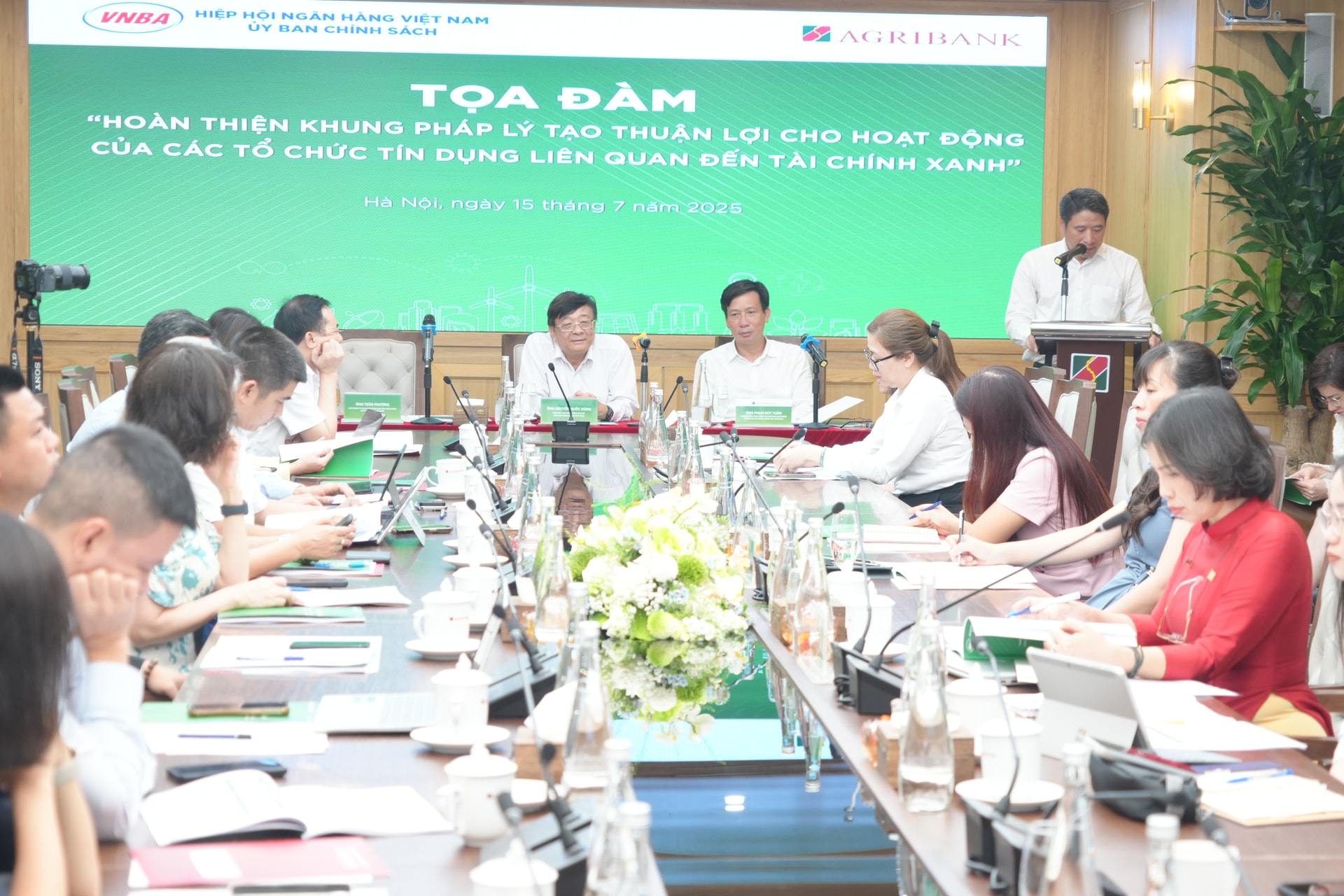In the context that the banking industry is actively innovating in the work of building and implementing laws, in line with the resolutions of the Politburo and the Government on green growth, the Seminar has become an important forum to propose appropriate policies to promote green finance activities, contributing to achieving the country's sustainable development goals.

Attending the discussion, on behalf of the State Bank of Vietnam (SBV), there was Ms. Pham Thi Thanh Tung, Deputy Director of the Department of Credit for Economic Sectors; along with representatives of the Legal Department, the Monetary Policy Department, and the State Bank Inspectorate. On behalf of the Ministry of Agriculture and Environment, there was Mr. Mai Thanh Dung, Deputy Director of the Institute of Strategy and Policy for Agriculture and Environment.
On behalf of VNBA, there were Dr. Nguyen Quoc Hung, Vice Chairman and General Secretary; Mr. Tran Phuong, Chairman of the Policy Committee (Deputy General Director of the Bank for Investment and Development of Vietnam - BIDV); Mr. Le Thanh Tung, Chairman of the Risk Committee (Member of the Board of Directors of the Vietnam Joint Stock Commercial Bank for Industry and Trade - VietinBank); members of the Policy Committee, the Working Group, and representatives of VNBA member credit institutions attending in person and online.
In his opening remarks, Dr. Nguyen Quoc Hung emphasized the Vietnamese Government's increasing interest in green growth activities, as demonstrated by the national strategies on green growth to 2030, vision 2050, as well as the Government's policies to support green projects. He affirmed that the banking sector plays a central role in mobilizing capital, promoting the transition to a green economy, through appropriate mechanisms and innovative financial instruments. However, he said that although the banking sector has achieved many achievements over the past 10 years, such as proactively greening internal operations and promoting investment in green finance, there are still many major challenges that need to be addressed. Specifically, the legal framework is not really synchronous and complete, limiting the ability to attract domestic and foreign capital to achieve the Net Zero target. According to the World Bank, by 2050, Vietnam will need about 368 billion USD (equivalent to 6.8% of GDP/year) to achieve net zero emissions, thus requiring more appropriate and effective capital mobilization mechanisms.
In addition, the green credit market, despite its annual growth rate of 20%, is still small compared to its potential, with outstanding green credit by the end of March 2025 reaching only over 704,200 billion VND, accounting for about 4.3% of the total outstanding debt of the entire economy. The main sectors attracting capital flows are renewable and clean energy (37%) and green agriculture (29%). Meanwhile, the green bond market has only issued about 1.16 billion USD in 5 years, too small compared to the capital demand of about 20 billion USD per year.
In addition, the exploitation of data in general and ESG data in particular is still limited, and the role of data as a strategic asset in the green transition has not been fully exploited.
In his speech, Mr. Tran Phuong emphasized the role of commercial banks in directing capital flows to green sectors. These banks have actively developed policies and strategies to green their operations, limit credit to high-emission sectors, and at the same time offer preferential interest rates for green loans, promote the issuance of ESG bonds and international cooperation to mobilize preferential resources from international financial institutions such as ADB and AFD. Banks have also improved their governance capacity, built internal processes, and established specialized committees on sustainable development and ESG to promote green credit for sustainable development.
On the SBV side, Ms. Pham Thi Thanh Tung said that the banking industry has made many efforts to facilitate green credit, through the issuance of policies and guidelines such as Circular No. 17/2022/TT-NHNN, amending Decree No. 156/2025/ND-CP, coordinating the development of policies to support interest rates of 2%/year for green projects according to Resolution No. 139/NQ-CP... Activities such as statistics on green sectors, guidance on ESG, and implementation of green credit programs such as lending for high-quality rice and reducing emissions in the Mekong Delta have also achieved positive results. However, Ms. Tung also pointed out difficulties, including incomplete policy institutions, challenges in mobilizing long-term capital due to the impact of economic and political factors, high interest rates, exchange rate risks, as well as uneven awareness among businesses and a lack of environmental information. In the coming time, the State Bank will focus on researching and guiding banks to lend to green projects, coordinate to develop interest rate support policies, improve the quality of human resources in green finance, and map out solutions to improve the quality of green finance human resources, at the same time, promote propaganda to raise public awareness of green growth.
To promote green credit capital to develop more strongly, there needs to be close coordination from ministries and branches in building a synchronous policy roadmap on taxes, fees, capital, markets, planning; developing the green bond market and domestic carbon market; proposing mechanisms to support credit institutions in accessing long-term, preferential international capital sources.
In the framework of the discussion, representatives from banks such as Agribank, BIDV, HDBank, along with international organizations and experts contributed many in-depth discussions on legal barriers and solutions to promote green finance in Vietnam. These proposals aim towards a sustainable green finance, contributing to the national green growth target and environmental protection, towards a green and prosperous future for Vietnam.
VNBA News
